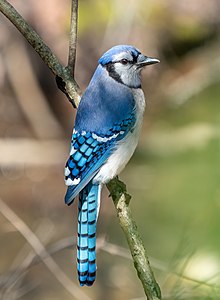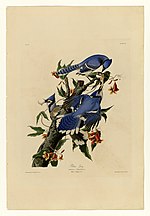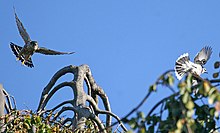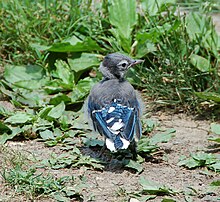Funny Blue Jay Pics Funny Blue Jay Animal Pics
| Blue jay Temporal range: Piacenzian - present | |
|---|---|
 | |
| In Prospect Park, Brooklyn, New York | |
| Conservation status | |
| | |
| Scientific nomenclature | |
| Kingdom: | Animalia |
| Phylum: | Chordata |
| Class: | Aves |
| Order: | Passeriformes |
| Family: | Corvidae |
| Genus: | Cyanocitta |
| Species: | C. cristata |
| Binomial name | |
| Cyanocitta cristata (Linnaeus, 1758) | |
| Subspecies | |
| 4 sspp., see text | |
 | |
| Approximate distribution map Year-round Nonbreeding | |
| Synonyms | |
| Corvus cristatus Linnaeus, 1758 | |
The blueish jay (Cyanocitta cristata) is a passerine bird in the family unit Corvidae, native to eastern North America. It lives in most of the eastern and central United States; some eastern populations may be migratory. Resident populations are too in Newfoundland, Canada; convenance populations are institute across southern Canada. Information technology breeds in both deciduous and coniferous forests, and is common in residential areas. Its coloration is predominantly bluish, with a white chest and underparts, and a blue crest; information technology has a black, U-shaped collar around its cervix and a black border behind the crest. Males and females are like in size and feather, and plumage does non vary throughout the year. Iv subspecies have been recognized.
The blue jay feeds mainly on seeds and nuts, such as acorns, which information technology may hide to eat subsequently;[ii] soft fruits; arthropods; and occasionally modest vertebrates. It typically gleans food from copse, shrubs, and the basis, and sometimes hawks insects from the air. Blueish jays can exist very ambitious to other birds; they sometimes raid nests and take decapitated other birds.[iii]
It builds an open up cup nest in the branches of a tree; both sexes participate. The clutch may be 2 to 7 eggs, which are blueish or light brown with darker chocolate-brown spots. Young are altricial, and are brooded by the female for 8–12 days after hatching. They may stay with their parents for one to two months.
The name jay derives from the bird's noisy, garrulous nature and has been practical to other birds of the same family unit, which are likewise mostly gregarious.[4] Jays are as well called jaybirds.[five]
Taxonomy [edit]
The blue jay was offset described every bit Pica glandaria cærulea cristata in English naturalist Marker Catesby's 1731 publication of Natural History of Carolina, Florida, and the Bahama islands.[vi] It was later described as Corvus cristatus in Carl Linnaeus' 1758 edition of Systema Naturae.[7] In the 19th century, the jay was described by French ornithologist Charles Lucien Bonaparte in 1838 as Cyanocorax cristatus in A geographical and comparative list of the birds of Europe and North America,[viii] and given its modernistic scientific name Cyanocitta cristata past Hugh Edwin Strickland in 1845.[9] The genus proper name Cyanocitta derives from the Greek words 'kyaneos' (blue) and the 'kitta' and 'kissa' (chattering bird, jay), and the term 'bluish chatterer' refers to the bright blueish plume of the head, nape, dorsum, and tail of the bird. The specific name cristata (crested, tufted) derives from Latin referring to the prominent blue crest of the jay.[x]
Description [edit]

The blue jay measures 22–30 cm (9–12 in) from bill to tail and weighs 70–100 one thousand (2.five–3.five oz), with a wingspan of 34–43 cm (13–17 in).[11] [12] Consistent with Bergmann'southward rule, jays from Connecticut averaged 92.4 yard (3.26 oz) in mass, while jays from warmer southern Florida averaged 73.7 g (2.60 oz).[xiii] [14] There is a pronounced crest on the head, a crown of feathers, which may be raised or lowered according to the bird'south mood. When excited or aggressive, the crest will be fully raised. When frightened, the crest bristles outwards, brushlike. When the bird is feeding among other jays or resting, the crest is flattened on the caput.[fifteen]
Its plumage is lavender-blue to mid-blue in the crest, back, wings, and tail, and its face is white. The underside is off-white and the cervix is collared with black which extends to the sides of the caput. The fly primaries and tail are strongly barred with black, heaven-blue, and white. The bill, legs, and eyes are all blackness. Males and females are almost identical, only the male is slightly larger.[12] [xvi] The black plumage on its nape, face, and throat varies extensively between individuals; it is believed to aid in recognition betwixt individuals.[12]
As with most other blue-hued birds, the blue jay's coloration is non derived from pigments but is the issue of lite interference due to the internal structure of the feathers;[17] if a blue feather is crushed, the bluish disappears because the construction is destroyed. The bodily paint in its feathers is melanin.[11] This is referred to as structural coloration.
Distribution and habitat [edit]
The blue jay occurs from southern Canada (including the southern areas of provinces from Alberta eastward to Quebec and throughout the Atlantic provinces) and throughout the eastern and cardinal The states due south to Florida and northeastern Texas. The western edge of the range stops where the arid pine wood and scrub habitat of the closely related Steller'south jay (C. stelleri) begins, generally in the eastern foothills of the Rocky Mountains. Recently, the range of the blueish jay has extended northwestwards then that information technology is now a rare only regularly seen winter visitor along the northern US and southern Canadian Pacific Coast.[11] As the two species' ranges at present overlap, C. cristata may sometimes hybridize with Steller's jay.[18] The increment in trees throughout the Great Plains during the past century due to fire suppression and tree planting facilitated the western range expansion of the bluish jay[19] [20] also every bit range expansions of many other species of birds.[21] [22] [23] From 1966 to 2015, the Blueish Jay experienced a population refuse along the Atlantic declension, but a greater than ane.5% annual population increase throughout the northern part of its range, including Labrador, Nova Scotia, southern Quebec, and southern Manitoba.[24]
The northernmost subspecies C. c. bromia is migratory, field of study to necessity. It may withdraw several hundred kilometers south in the northernmost parts of its range. Thousands of blue jays accept been observed to migrate in flocks along the Bang-up Lakes and Atlantic coasts. It migrates during the daytime, in loose flocks of 5 to 250 birds. Much about their migratory beliefs remains a mystery. Some are nowadays throughout winter in all parts of their range. Young jays may be more likely to migrate than adults, just many adults also migrate. Some individual jays migrate south 1 year, stay north the next winter, and and then migrate due south again the next year. To date, no ane has concretely worked out why they drift when they practise. Likely, information technology is related to atmospheric condition conditions and how abundant the winter nutrient sources are, which can determine whether other northern birds will move south.[25]
The blue jay occupies a variety of habitats within its big range, from the pino woods of Florida to the spruce-fir forests of northern Ontario. It is less abundant in denser forests, preferring mixed woodlands with oaks and beeches.[15] It has expertly adapted to homo activity, occurring in parks and residential areas, and can adjust to wholesale deforestation with relative ease if human being activeness creates other ways for the jays to become by.[26]
Subspecies [edit]
Four subspecies are by and large accepted, though the variation within this species is rather subtle and substantially clinal. No firm boundaries can be drawn between the inland subspecies. The ranges of the coastal races are amend delimited.[16]
| Image | Subspecies | Mutual Name | Description | Distribution |
|---|---|---|---|---|
 | Cyanocitta cristata bromia | Northern blueish jay | The largest subspecies, with fairly dull plumage. Blue is rather pale. | Canada and northern U.s.. |
 | Cyanocitta cristata cristata | Coastal blue jay | Mid-sized and vivid blue. | Coastal U.s.a. from North Carolina to Texas, except southern Florida |
 | Cyanocitta cristata cyanotephra | Interior blue jay | Mid-sized, quite dark blue on pall contrasting cleanly with very white underside. | Inland Us, intergrading with C. c. bromia to the north. |
| | Cyanocitta cristata semplei | Florida blue jay | The smallest subspecies, much like C. c. bromia in colour. | Southern Florida. |
-

C. c. bromia, Northern bluish jay, juvenile, in Ontario, Canada
-

C. c. bromia, Northern blueish jay in Ontario, Canada
-

Bluish Jay, Melbourne Florida
Behavior [edit]

The blue jay is a noisy, assuming, and aggressive passerine. Information technology is a moderately slow flier (roughly 32–40 km/h (20–25 mph)) when unprovoked.[27] It flies with trunk and tail held level, with tedious wing beats. Its slow flight speeds brand this species like shooting fish in a barrel prey for hawks and owls when information technology flies in open areas. Virtually all the raptorial birds sympatric in distribution with the blueish jay may prey upon it, especially swift bird-hunting specialists such every bit the Accipiter hawks. Diverse predators may casualty on jay eggs and young upwardly to their fledgling stage, including tree squirrels, snakes, cats, crows, raccoons, opossums, other jays and possibly many of the same birds of casualty who assail adults.[28]
The bluish jay can exist beneficial to other bird species, as it may chase predatory birds, such as hawks and owls, and will scream if it sees a predator within its territory. It has also been known to sound an alarm call when hawks or other dangers are almost, and smaller birds often recognize this call and hide themselves away accordingly. It may occasionally impersonate the calls of raptors, particularly those of the red-tailed and scarlet-shouldered hawks, possibly to test if a hawk is in the vicinity, though also perchance to scare off other birds that may compete for food sources.[25] It may also be aggressive towards humans who come close to its nest, and if an owl roosts near the nest during the daytime the blueish jay mobs information technology until it takes a new roost.[29] All the same, blue jays accept also been known to assail or kill other smaller birds, and foliage-roosting bat species such as Eastern cherry-red bats.[30] Jays are very territorial birds, and they will chase others from a feeder for an easier meal. Additionally, the blue jay may raid other birds' nests, stealing eggs, chicks, and nests. However, this may non be equally common as is typically thought, as only 1% of food matter in i study was bird material.[25] Despite this, other passerines may still mob jays who come within their breeding territories.
When a blue jay is agitated or aroused, the blue crest atop its caput will ascension. It will lower when the bird is relaxed or at-home.[31]

Blue jays, like other corvids, are highly curious and are considered intelligent birds. Young individuals playfully snatch brightly coloured or reflective objects, such as bottle caps or pieces of aluminum foil, and carry them around until they lose interest.[29] While not confirmed to accept engaged in tool use in the wild, blue jays in captivity take been observed using strips of newspaper as tools to obtain nutrient,[25] [32] while captive fledglings have been observed attempting to open the doors of their cages.[33]
Nutrition [edit]
Blueish jays are omnivorous, but the Audubon Society estimates that 75% of their nutrition is vegetable matter.[34] They have strong blackness bills which they use for corking nuts, ordinarily while holding them with their feet, and for eating corn, grains and seeds. Bluish jays especially love to consume peanuts in the shell. [35] Its nutrient is sought both on the ground and in copse and includes virtually all known types of plant and animal sources, such equally acorns and beech mast, weed seeds, grain, fruits and other berries, peanuts, bread, meat, small invertebrates of many types, scraps in boondocks parks, bird-table food and rarely eggs and nestlings.[25] Blueish jays volition sometimes enshroud food, though to what extent differs widely among individuals.[36] Although seemingly contentious in their general behavior, blue jays are frequently subservient to other medium-sized birds who visit bird-feeders. In Florida, blue jays were dominated at feeders past eastern gray squirrels, Florida scrub-jays, common grackles and blood-red-headed woodpeckers, all of which were occasionally observed to aggressively forbid the jays from feeding.[25]
Reproduction [edit]

Nest in the top of a little pine

The mating flavour begins in mid-March, peaks in mid-April to May, and extends into July. Whatever suitable tree or large bush may be used for nesting, though an evergreen is preferred. The nest is preferentially built at a height in the trees of iii to x m (10 to 33 ft). It is cup-shaped and equanimous of twigs, small roots, bark strips, moss, other constitute cloth, cloth, paper, and feathers, with occasional mud added to the cup.

Juvenile vocalizing in July
Blue jays are not very picky about nesting locations. If no meliorate place is available – east.m. in a heavily deforested expanse – they will even use places similar the big mailboxes typical of the rural United States.[26] They also appropriate nests of other mid-sized songbirds as long as these are placed in suitable spots; American robin nests are usually used past blue jays, for example.

Blue jays typically form monogamous pair bonds for life. Both sexes build the nest and rear the immature, though only the female broods them. The male feeds the female person while she is brooding the eggs. At that place are ordinarily between 3 and 6 (averaging 4 or 5) eggs laid and incubated over 16–xviii days. The young fledge usually between 17 and 21 days afterward hatching.[29]
After the juveniles fledge, the family travels and forages together until early fall, when the immature birds disperse to avoid contest for food during the winter. Sexual maturity is reached after one yr of age. The oldest known wild, banded Blue Jay was at least 26 years, 11 months former when information technology was found dead subsequently being caught in line-fishing gear. Information technology had been banded in the Newfoundland/Labrador/St. Pierre et Miquelon surface area in 1989 and was found there in 2016.[37] Some other wild jay was found to have been effectually 17 and a half years old.[38] A more than common lifespan for wild birds that survive to adulthood is around 7 years.[39] Beyond predation and the occasional standoff with man-fabricated objects, a common cause of mortality in recent decades has been the West Nile virus, to which corvids as a whole seem especially susceptible. However, despite several major local declines, overall blueish jays accept not seemed to have been depleted by the affliction.[28]
Vocalizations [edit]
Blue jays can make a big diversity of sounds, and individuals may vary perceptibly in their calling fashion. Similar other corvids, they may learn to mimic human being speech. Blue jays can also re-create the cries of local hawks so well that information technology is sometimes difficult to tell which it is.[forty] Their voice is typical of most jays in being varied, but the most commonly recognized sound is the alarm call, which is a loud, most gull-like scream. There is also a high-pitched jayer-jayer call that increases in speed as the bird becomes more agitated. This particular call can exist easily confused with the chickadee's vocal because of the dull-starting chick-ah-dee-ee. Blue jays will use these calls to band together to mob potential predators such as hawks and bulldoze them abroad from the jays' nests.
Blue jays as well have tranquillity, well-nigh subliminal calls which they use among themselves in proximity. One of the most distinctive calls of this type is often referred to as the "rusty pump" owing to its squeaky resemblance to the sound of an old hand-operated water pump. The blueish jay (and other corvids) are distinct from near other songbirds for using their call equally a song.
In man culture [edit]
In old African American folklore of the southern United States, the blue jay was a significant metaphysical creature. In some tales, the blueish jay was credited with making the globe "when all de worl' was water" by bringing the beginning "grit" or "dirt". In other tales the bluish jay was temporarily conscripted every bit a servant of the Devil to bring "kindling" to the "bad place": and "was not encountered on a Friday every bit he was fetching sticks downward to Hell; furthermore, he was so happy and chirpy on a Saturday as he was relieved to return from Hell".[41]
The blue jay was adopted as the team symbol of the Toronto Blue Jays Major League Baseball team, as well as some of their minor league affiliates. Their mascot, Ace, is an anthropomorphic blue jay. The blue jay is also the official mascot for Johns Hopkins Academy, Elmhurst Academy, and Creighton Academy. The latter two spell the proper name equally one word - Bluejay. It is also the provincial bird of the province of Prince Edward Isle in Canada.
References [edit]
- ^ BirdLife International. (2016). Cyanocitta cristata. The IUCN Reddish List of Threatened Species. doi:10.2305/IUCN.UK.2016-3.RLTS.T22705611A94027257.en
- ^ "The blue jays are coming! Hide yo kids, hide yo nuts!". Seriously, Scientific discipline?.
- ^ Piffling Known Fact: Blueish Jays are Vicious Carnivores. pedaldrivenprogramming.com (15 Apr 2008)
- ^ Coues, Elliot (1890). Key to North American birds (5th ed.). Boston, MA: Estes and Lauriat. p. 326. OCLC 469020022.
- ^ "jaybird – definition of jaybird by the Gratis Online Dictionary, Thesaurus and Encyclopedia". Retrieved April twenty, 2011.
- ^ Catesby, Mark (1731). Natural History of Carolina, Florida, and the Bahamas (1st ed.). London: Majestic Society House. p. 87.
- ^ Linnaeus, C. (1758). Systema Naturae per Regna Tria Naturae, Secundum Classes, Ordines, Genera, Species, cum Characteribus, Differentiis, Synonymis, Locis. Tomus I. Editio Decima, Reformata (in Latin). Vol. 1. Holmiae: Laurentius Salvius. p. 106.
- ^ Bonaparte, Charles L. (1838). A geographical and comparative listing of the birds of Europe and North America. London: J. Van Voorst. p. 27.
- ^ Message of the National History Survey, Issues 4-half dozen. Chicago: Chicago Academy of Sciences. 1900. p. 120.
- ^ Sandrock, James (2014). The Scientific Nomenclature of Birds in the Upper Midwest. University of Iowa Press. p. 48. ISBN978-1609382254.
- ^ a b c Blue Jay, Life History, All Virtually Birds. Cornell Lab of Ornithology
- ^ a b c "ADW: Cyanocitta cristata: Data". Fauna Diversity Web.
- ^ Jewell, South. D. (1986). "Weights and wing lengths in Connecticut Blue Jays". Connecticut Warbler. 6 (iv): 47–49.
- ^ Fisk, East.J. (1979). "Fall and winter birds most Homestead, Florida". Bird-Banding. 50 (3): 224–303. doi:10.2307/4512458. JSTOR 4512458.
- ^ a b "Bluish Jay". Canadian Wildlife Service. Archived from the original on 2009-02-04. Retrieved 2009-08-09 .
- ^ a b Madge, Steve; Burn, Hilary (1994). Crows and jays: a guide to the crows, jays and magpies of the world. London: A&C Blackness. ISBN978-0-7136-3999-v.
- ^ Carpenter, Anita (February 2003). "What Color is a Bluejay?". Wisconsin Natural Resources Magazine. Archived from the original on 2018-07-31. Retrieved 2012-x-21 .
- ^ Rhymer, Judith Chiliad.; Simberloff, Daniel (1996). "Extinction by hybridization and introgression". Annu. Rev. Ecol. Syst. 27: 83–109. doi:x.1146/annurev.ecolsys.27.i.83.
- ^ Smith GH (1978). "Range Extension of the Blue Jay into Western Northward America" (PDF). Bird-Banding. 49 (3): 208–214. doi:x.2307/4512360. JSTOR 4512360.
- ^ Tarvin KA, Woolfenden GE. (1999). "Blue Jay (Cyanocitta cristata)", no. 469. In: A. Poole (ed.). The Birds of North America Online. Cornell Lab of Ornithology, Ithaca, New York.
- ^ Livezey, KB (2009). "Range expansion of Barred Owls, part I: chronology and distribution". American Midland Naturalist. 161: 49–56. doi:x.1674/0003-0031-161.one.49. S2CID 86276981.
- ^ Livezey, KB (2009b). "Range expansion of Barred Owls, part ii: facilitating ecological changes". American Midland Naturalist. 161 (2): 323–349. doi:ten.1674/0003-0031-161.2.323. S2CID 84426970.
- ^ Livezey KB (2010). "Killing Barred Owls to Assist Spotted Owls Two: Implications for Many Other Range-Expanding Species". Northwestern Naturalist. 91 (iii): 251–270. doi:10.1898/NWN09-38.1. JSTOR 40983223. S2CID 85425945.
- ^ "Blue Jay Cyanocitta cristata Bbs Trend Map, 1966 - 2015". USGS. U.S. Department of the Interior. Retrieved 2020-12-09 .
- ^ a b c d e f Blue Jay. birds.cornell.edu
- ^ a b Henninger, Westward. F. (1906). "A preliminary list of the birds of Seneca County, Ohio" (PDF). Wilson Bulletin. 18 (2): 47–60.
- ^ Animal Speeds. Texas Parks & Wildlife. Retrieved July 1, 2008.
- ^ a b "ADW: Cyanocitta cristata: INFORMATION". Animal Diversity Web.
- ^ a b c "Blue Jay". Archived from the original on 2007-05-02.
- ^ Clay, William M. (1959). "Blue Jays Attack a Carmine Bat" (PDF). The Auk. 76 (4): 532. doi:10.2307/4082327. JSTOR 4082327.
- ^ "The Truth Nearly Blue Jays – The Gratuitous Weekly". Retrieved 2019-09-08 .
- ^ Jones, Thony B.; Kamil, Alan C. (1973). "Tool-Making and Tool-Using in the Northern Blue Jay". Science. 180 (4090): 1076–1078. Bibcode:1973Sci...180.1076J. doi:10.1126/science.180.4090.1076. PMID 17806587. S2CID 22011846.
- ^ American Rivers Archived 2013-12-18 at the Wayback Machine. tumblr.com
- ^ "Blueish Jay Cyanocitta cristata". Audubon.org. 13 November 2014.
- ^ "Bluish jays love peanuts in the vanquish".
- ^ AllAboutBirds.org – Blue Jay The Cornell Lab of Ornithology
- ^ "Blue Jay Overview, All About Birds, Cornell Lab of Ornithology".
- ^ "Longevity Records Of Northward American Birds". U. S. Geological Survey: Bird Banding Laboratory. Retrieved 24 December 2012.
- ^ "Animal facts: Blue Jay". Canadian Geographic. The Royal Canadian Geographical Society. July 26, 2006. Retrieved Feb 3, 2019.
- ^ George, Philip Brandt. (2003). In: Baughman, Mel Yard. (ed.) Reference Atlas to the Birds of North America. National Geographic Society, Washington, D.C., p. 279, ISBN 978-0-7922-3373-2
- ^ Ingersoll, Ernest (1923). Birds in legend, fable and folklore. New York: Longmans, Green and Co. pp. 166–167. Retrieved 2009-08-08 .
External links [edit]
-
 Data related to Cyanocitta cristata at Wikispecies
Data related to Cyanocitta cristata at Wikispecies - Blue Jay ID, including sound and video, at Cornell Lab of Ornithology
- Blueish Jay – Cyanocitta cristata – USGS Patuxent Bird Identification InfoCenter archived May 2010
- "Bluish Jay media". Cyberspace Bird Collection.
- Blue Jay at borealforest.org archived May 2021
- Blueish Jay Bird Sound at Florida Museum of Natural History archived January 2011
- Photo essay of blue jay nestlings archived April 2014
- Blueish Jay photo gallery at VIREO (Drexel University)
Source: https://en.wikipedia.org/wiki/Blue_jay

0 Response to "Funny Blue Jay Pics Funny Blue Jay Animal Pics"
Post a Comment